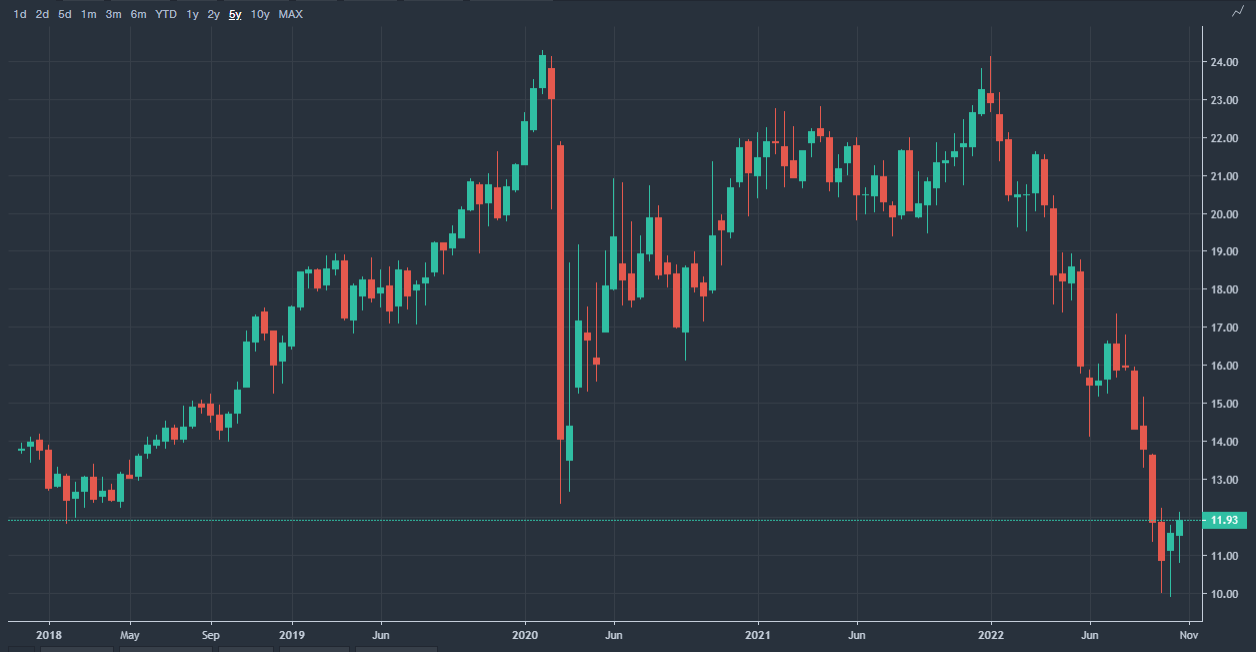
Medical Properties Trust Inc. (NYSE:MPW) is a Birmingham, Alabama-based healthcare real estate investment trust (REIT) that owns and operates 434 properties across 10 countries, with locations in the U.S., Europe and Australia. Sixty-two percent of its properties are in the United States.
According to its website, Medical Properties Trust invests in “acute care, rehabilitation, long-term acute care hospitals and other real estate facilities that generally require physician orders for admission.” The company’s gross assets have doubled over the past four years and now stand at $21.1 billion. Its market capitalization is $6.74 billion.
Here is a breakdown of its facilities:
General acute care hospitals: 72%
Behavioral health facilities: 11%
Inpatient rehabilitation hospitals: 9%
Other company facilities: 8%
The 52-week range for Medical Properties Trust is $9.90 to $24.13, and its most recent price was $11.26. The 53% decline off the high has spawned a slew of recent opinions as to the future prospects of Medical Properties Trust and whether or not the time is right to purchase this stock. To begin, take a closer look at its most recent quarterly report:
On Oct. 27, Medical Properties Trust reported mixed third-quarter operating results.
|
Categories |
3rd Quarter 2022 |
3rd Quarter 2021 |
|
AFFO |
$0.36 per share |
$0.34 per share |
|
REVENUE |
$352.3 million |
$390.8 million |
|
NET INCOME |
$222 million, $0.37 per diluted share |
$171 million, $0.29 per diluted share |
See also: This Little-Known REIT Is Producing Double-Digit Returns In A Bear Market: How?
Wall Street was expecting $0.35 per share on revenue of $389 million, so the company beat the estimates on adjusted funds from operation (AFFO) but fell way short on revenue. The funds from operation (FFO) was $0.45 per share, in line with expectations but below the $0.46 FFO for the second quarter.
“Performance at our facilities generally improved during the second and third quarters, reflecting the resilience of well-underwritten, infrastructure like hospitals. … Forecasted escalations in our (consumer price index) CPI-linked leases point to overall cash rent growth in the 4% to 5% range for next year, a pace likely to match up well with anticipated hospital industry revenue trends,” Founder, Chairman and CEO Edward K. Aldag, Jr. said
Despite the improvements noted by the CEO, investors are within their rights to ask why Medical Properties stock performed so poorly in 2022. Its one-year negative return of 43.19% is far below the returns for other healthcare REITs such as Omega Healthcare Investors Inc., Sabra Health Care REIT Inc., Physicians Realty Trust and National Health Investors Inc. The current price is 33.8% below its 200-day simple moving average (SMA).
Some of the reasons for the price decline were higher Federal Reserve interest rates in addition to declining revenue and FFO. Management also tempered its previous prediction of a $1 billion to $3 billion range of acquisitions by noting it would be more likely to fall on the lower end of that range. Weak earnings from the first quarter of 2022, a reduction in second-quarter revenue and management’s reluctance to increase its annual forecast were other factors contributing to the falling price. The 2022 portion of the chart tells the story:

But the most likely reason for its price decline was fears about future performance by Steward Medical Group, a company whose financial outlook, according to a February 2022 Wall Street Journal article, was on very shaky ground. The Journal alleged that Steward was having financial difficulties and that having lost $800 million over a three-year period, it was actually being loaned money by Medical Properties Trust to pay its rent and other bills.
Steward is Medical Properties Trust’s largest client with 41 facilities across six regions but with all of the facilities tied to one master lease agreement. This means that almost a third of Medical Properties Trust’s revenue is garnered from one tenant, and that tenant has been strongly rumored to have substantial financial problems.
The Journal reported that in 2020, Steward was actually providing 30% of Medical Properties Trust’s total revenue. In addition, Medical Properties also has loans of over $362 million and a $139 million equity stake in Steward.
Percentage breakdown of Medical Properties Trust’s total third-quarter revenue from Steward alone by market area (from a third-quarter report on company Website):
Florida: 6.6%
Utah: 8.6%
Massachusetts: 5.7%
Texas/Arkansas/Louisiana: 5.5%
Arizona: 2.2%
Ohio/Pennsylvania: 0.9%
TOTAL: 29.5%
Medical Properties Trust fought back against the Journal’s article and other rumors in late April, with Aldag denying the allegations made by the WSJ and offering more transparency about joint ventures between Medical Properties Trust and Steward Medical Group. The stock jumped 6% that day, but much of the damage had already been done. The stock continued its decline throughout much of 2022.
But some positive recent news should help Steward pay the rents going forward. On Oct. 11, a Massachusetts jury awarded Steward Medical Group $16 million in damages and interest against Compass Medical Group P.C.
Ironically, Compass Medical first sued Steward, claiming Steward had breached a services agreement for unpaid bonuses, equipment rentals and office space. But the jury rejected all of Compass Medical’s claims, saying it had committed fraud against Steward Medical Group and awarded Steward $16 million.
Earlier this year, Medical Properties Trust completed a $1.7 billion deal with Macquarie Asset Management (MAM) in which Macquarie will take a 50% interest in eight general acute-care hospitals that Steward Medical Group operates. This not only will bring substantial cash to Medical Properties Trust, but it also signifies that Macquarie has faith in Steward’s ability to continue remediating its financial problems.
Steward has also recently announced that going forward it believes it will generate positive and sustainable free cash flow. So all of this is a plus for both Steward and Medical Properties Trust. But is it too late to put the genie back in the bottle?
As for debt levels, Medical Properties Trust has been making some progress and working diligently to bring down its total debt to about $8 billion, which should give it a workable debt to earnings before interest, taxes, depreciation and amortization (EBITDA) ratio of about 6.5 times in the near future.
Over the past five years, the $0.24 quarterly dividend has increased by 20.8% and is now $0.29. During that time, there have been no cuts or eliminations to the dividend. The annual dividend of $1.16 now yields 10.3% and is still well covered by FFO of $1.81.
Despite the high yield, the dividend/FFO ratio of 64% is perfectly reasonable, and the P/FFO of 6.22 is far below its peer group. This would suggest that the dividend, despite being 71% above its five-year average, could be safe for the immediate future. On its website, Medical Properties Trust proudly notes that it has raised its quarterly dividend for eight consecutive years.
This past month there was some interesting company news. In early October, Medical Properties Trust announced it had put Connecticut hospitals under contract to sell to Prospect Medical Holdings, which is the current lessee.
However, the aggregate sale price of $457 million is approximately the same amount that Medical Properties Trust paid for the hospitals in 2019. So, basically, Medical Properties did not make anything on appreciation over three years — just the rent payments of $104 million from Prospect.
Medical Properties also announced the sale of 11 facilities to Prime Healthcare, along with repayments from Prime of various loans that will be used to reduce short-term debt.
In addition, on Oct. 10, Medical Properties Trust announced that the board of directors had authorized the repurchase of up to $500 million in common stock before October 2023. That could help boost its stock price and reduces the amount it has to pay out in dividends.
In summary, Medical Properties Trust does have some positives, and its price may well have bottomed for the time being. The dividend, although well above its five-year average, is probably safe for the immediate future. FFO is more than enough to cover the dividend, and the company is working to reduce its debt load.
Nevertheless, many investors have already lost faith in Medical Properties, especially with its resistance to providing more public information about Steward in its 10-K report. Although Steward sounds optimistic in its public statements, it remains to be seen whether it will be able to right the ship and repay its debts.
Declining revenue over the third quarter of 2022 is one concern. Another concern is why did Medical Properties Trust allow itself to have one healthcare company grow to almost a third of its tenant base, and how smart will that decision look if Steward is unable to get its financial house in order? One of the strengths of a REIT that investors look for is the diversification of its tenant base so that the loss of rent from any one tenant doesn’t hurt its bottom line too much.
On its website, Medical Properties notes that it has 54 different operators and had a “36% decrease in exposure to our largest operator,” without mentioning the lofty previous percentage it was decreasing the exposure from.
Much of the preceding concerns are already baked into the stock price, but certainly, there are REITs within the healthcare sector that have fewer risks at the moment than Medical Properties Trust. It’s a matter of whether investors want to trade off some safety for the high yield of the current dividend.
REITs have bounced back strongly over the last month, and looking at the performance of Medical Properties Trust over the past month, it is actually up 14.7%. But several other healthcare REITs have outperformed it, such as Global Medical REIT Inc. (31.77%), Universal Health Realty Income Trust (19.27%) and Caretrust REIT Inc. (17.2%). Investors should always favor the strongest stocks of a sector over ones with weaker relative strength.
Other REITs, such as Omega Healthcare Investors Inc., Healthpeak Properties Inc. and Sabra Health Care REIT Inc. that have greatly outperformed Medical Properties Trust over the last 52-week period, were all within 1.5% of Medical Properties Trust performance over the past month. In fact, Omega Healthcare Investors is actually up more than 12% over 52 weeks, while most healthcare REITs have declined.
A large pullback off a 52-week high is not in itself a sufficient reason to buy a stock. A stock can be cheap and remain cheap for a long time. There are questions regarding some of the decisions that Medical Properties Trust has made and its relative strength to its peer group is somewhat tepid at best.
As Margaret Mitchell, author of “Gone with the Wind” once said, “What's broken is broken — and I'd rather remember it as it was at its best than mend it and see the broken places as long as I live.”
See more on real estate investing from Benzinga







